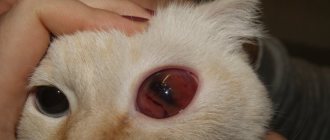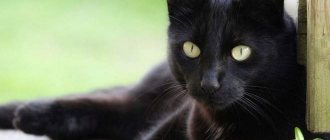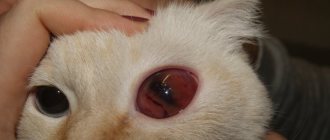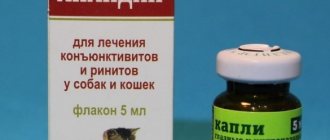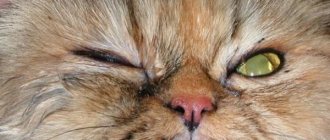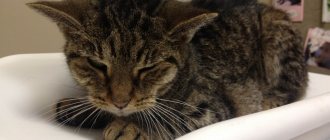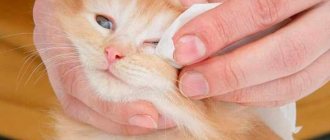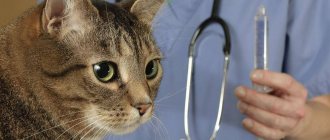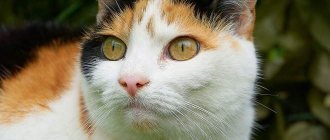Causes and mechanism of development
Panophthalmitis can be caused by exogenous or endogenous causes. In both cases, an infection penetrates into the eyeball. The causative agents are staphylococci, streptococci, Pseudomonas aeruginosa and other pathological microorganisms. They can enter the eye tissue through a penetrating injury (for example, when the eye is damaged during a cat fight or a piece of glass enters the cornea), or a burn.
Panophthalmitis can also develop against the background of:
- infectious uevitis (inflammation of the choroid of the eye),
- bacterial keratitis (inflammation of the cornea of the eye),
- purulent conjunctivitis,
- chlamydial trachoma.
When a pathogen penetrates the tissue of the eyeball, protective mechanisms are activated in the cat’s body. The immune system begins to produce large quantities of E-lymphocytes, antibodies, the formation of which is accompanied by a powerful release of inflammatory mediators. However, due to the increased vulnerability of the delicate tissues of the organ of vision, all layers of the eyeball are very quickly damaged, up to complete destruction (“melting”). With further development of the disease, the purulent process also affects the surrounding soft tissues (eyelids, eye muscles).
Panophthalmitis in a cat
Dacryocystitis
Dacryocystitis is an inflammation of the lacrimal sac, accompanied by a violation of the patency of the nasolacrimal canal due to its narrowing.
Cause. The disease in cats occurs as a result of chronic conjunctivitis.
Clinic. During a clinical examination, a veterinarian notes mucous or purulent discharge from the eyes of a sick cat. In the outer upper corner of the eye orbit, a swelling is visible, which is painful on palpation. The upper eyelid is swollen, the lacrimal gland is enlarged on palpation. Sometimes there is an accumulation of pus in the tissues around the eyes.
Treatment. Treatment of dacryocystitis in cats can be symptomatic or surgical. Symptomatic treatment consists of relieving inflammation and pain by using novocaine blockades and absorbable ointments (Vishnevsky ointment, ichthyol). Surgical treatment consists of cleaning the lacrimal canal or extirpation of the lacrimal gland.
Symptoms
Panophthalmitis develops very quickly, literally in a few days. The cat suddenly develops severe lacrimation; due to sharp pain in the eye, the animal becomes restless, cannot find a place for itself, often rubs the damaged eye with its paw, sleeps and eats poorly. There is photophobia, redness and swelling of the eyelid. The cornea of the cat's eye becomes cloudy, and he practically ceases to see. Then a purulent process develops: as a result of the disintegration of the iris and cornea, exudate accumulates between the lens and the retina. The eye partially loses its mobility, its eyelids involuntarily close, at the same time the eyeball noticeably moves forward. During this period, the cat may have a fever and elevated temperature.
Attention! If you notice the symptoms described, you should contact your veterinarian immediately. Pathological microorganisms that enter the eyeball multiply very quickly, and in the absence of timely assistance, the infection can affect the brain and spread to the entire body. Then the cat will inevitably die from sepsis. Treatment of panophthalmitis at home is unacceptable; this disease can only be treated in a hospital setting, in a veterinary clinic.
Entropion of the eyelids
Cause. Entropion of the eyelids in cats occurs as a result of certain eye diseases (conjunctivitis, blepharitis, etc.) and exposure to certain chemicals. A genetic predisposition in some cat breeds (Sphynxes, Persians) leads to bloat.
Clinical signs. During a clinical examination, the veterinarian notes that the eyelid turns inward. As a result of mechanical irritation, redness of the eyeball and symptoms of blepharospasm are noted. When examining the cornea, we record the presence of ulcers in the place of constant contact with the eyelid, and lacrimation.
Treatment. Carrying out a surgical operation.
Diagnosis and treatment
When making a diagnosis, the doctor mainly focuses on the detected signs of purulent inflammation of the eyeball and the presence of a history of acute infectious diseases or eye injuries. To identify the type of microbial flora that caused the pathology, a myringotomy (puncture) of the cornea is performed, and the resulting exudate sample is sent to the laboratory for bacteriological and microscopic analysis.
If the disease is detected at a very early stage, conservative treatment is possible. To relieve pain, the cat is given an infraorbital novocaine blockade. The anesthetic is injected behind the eyeball, penetrating there through the skin of the lower and upper eyelids. In some cases, syntomycin or sulfacyl ointment is added to the anesthetic to enhance the therapeutic effect.
In any case, a cat with panophthalmitis is given intensive antibiotic therapy. Broad-spectrum antibiotics are used:
- ampicillin;
- amoxiclav;
- gentamicin;
- streptomycin;
- neomycin;
- biosol;
- bicilin;
- neopen;
- tetracycline.
The duration of treatment depends on the degree of damage to the eyeball and the type of pathogen; the minimum course of antibiotic therapy is a week. In most cases, antibiotics are administered to cats by injection, since it is not always possible to force a seriously ill animal to eat a pill.
However, most often panophthalmitis has to be treated surgically. There are two options for this operation; in both cases, the diseased eye completely loses its functions.
Evisceration
Resection of the eyeball is performed under general anesthesia. During the operation, an incision is made on the cornea and sclera, through which the contents of the eye are removed with a special instrument (curette). In this case, the fibrous membrane of the eyeball is left. Sutures are placed on the sclera and cornea. After completion of the operation, hemostasis (stopping bleeding) and treatment of the sutures with an antiseptic is performed. If necessary, drainage of the eye cavity can be performed. Postoperative sutures are removed after 1-2 days.
Enucleation
This option involves removing the entire diseased organ of vision under general anesthesia: the eyeball and intraocular structures. The operation scheme is as follows:
- The eye muscles are fixed with a surgical hook and cut off.
- By pulling the eyeball forward, the optic nerve located behind it is cut off.
- The eyeball, devoid of connecting elements, is removed.
- Stop bleeding using a tampon with hydrogen peroxide.
- The eyelids are sutured with a purse string suture.
About prognosis after surgery
After the blood clot in the eye cavity has dissolved, after about a month, it will be noticeable that the size of the “closed” operated eye is smaller than that of a healthy one. But this cosmetic defect does not prevent the animal from living a full, active life.
Third eyelid prolapse
Prolapse of the third eyelid in a cat is often a secondary symptom of a number of infectious and parasitic eye diseases; it occurs when the optic nerve becomes inflamed.
Clinic. Cat owners and veterinary specialists use eyelids, which sometimes reach up to 1/3 of the entire visual area.
Treatment. Third eyelid prolapse in cats can be treated symptomatically or surgically. Treatment should be aimed at eliminating the primary disease that led to the loss of the third eyelid. Surgical treatment involves surgical excision of the prolapsed third eyelid.
Symptoms
The disease develops rapidly - within a few days. The incubation period for panophthalmitis is 2-3 days after infection enters the eye. Symptoms of the disease:
- purulent discharge sticking together the eyelids;
- temperature increase;
- blepharospasm;
- increased lacrimation;
- loss of appetite or complete refusal to eat;
- wrinkling and atrophy of the eyes;
- exophthalmos (protrusion of the eyeball);
- soreness in the eyes;
- clouding of the lens and cornea;
- redness and swelling of the eyelids;
- conjunctivitis;
- intolerance to light.
The cat does not strive to play, becomes lethargic, and constantly rubs its eyes. Vision deteriorates and the pet may go blind. Due to the sharp pain, the cat suffers, becomes restless, and cannot find a place for itself. The purulent process does not develop immediately, but after a few days. Exudate accumulates between the retina and the lens. The mobility of the eye is lost, the eyeball is displaced, and the pet develops a fever.
Treatment
Treatment should begin immediately after the first symptoms appear. Otherwise, sepsis or bacterial meningitis may develop, and this leads to the death of the pet. First, drug treatment is prescribed; in advanced cases, surgery is required when the eye is completely removed. You cannot provide first aid yourself; this may worsen the cat’s condition. Treatment is carried out only in a hospital setting, in a veterinary clinic.
Basic treatment
In the initial stage of the disease, a novocaine blockade is performed to reduce pain. The painkiller is injected behind the apple. To enhance the effect, sulfacyl or syntomycin ointment is added. To eliminate the infection, the cat is given orally (or injected) with broad-spectrum antibiotics:
- "Amoxiclav";
- "Biosol";
- "Neomycin";
- "Neopen";
- "Ampicillin";
- "Tetracycline";
- "Gentamicin";
- "Bicilin";
- "Streptomycin".
The duration of antibacterial therapy depends on the stage of the disease and the pathogen. The minimum treatment time with antibiotics is a week. Most often, medications are administered by injection; it is difficult to force your pet to swallow pills. To avoid addiction, after 14 days the antibiotics are changed to another drug.
Sulfonamides (Biseptol, Streptotsid, Etazol sodium), and ophthalmic drugs (Levomekol drops, Dekta-2, Tetracycline ointment, Gentapharm, Anandin) can also be prescribed.
Surgery
Three types of operations can be used as a surgical intervention. During evisceration, the structures of the apple are removed - the lens, retina, uveal tract, vitreous body. During enucleation, the eyeball is excised and some parts of the visual apparatus are partially removed. During exenteration, the organ is completely removed. The affected tissues are also excised - nerves, muscles, eyelids, blood vessels, lacrimal canal. The eye socket becomes empty, the skin around it is sewn together, and sutures are placed.
What to do at home
The owner must strictly follow the veterinarian’s instructions and provide the pet with good living conditions, rest and adequate nutrition. It is recommended to reduce physical activity.
Under no circumstances should you self-medicate or use medications purchased without consulting a specialist. But phytomineral fertilizer containing ivy bud, plantain, cornflower and calendula can be given without fear.
Remember that if you try to insert a membrane yourself, you can cause irreparable harm to your vision.
During treatment, the cat must rinse its eyes. But for this you should not use the good old folk methods, such as strong tea, but special drugs that relieve inflammation.
A good result is obtained by the Beaphar Oftal eye wash, sold in a veterinary pharmacy. It does an excellent job of cleaning the eyes and fur around them from debris, stimulates self-cleaning and prevents the appearance of tear stains.
After washing the organ of vision, eye drops are used. Among those recommended by veterinarians are Actipol, Levomycetin, Floxal. These drugs are most effective for conjunctivitis and infections. The use of two drugs simultaneously enhances the therapeutic effect. As a rule, experts advise combining Floxal with Korneregel. The course is at least 14 days.
Drops are the most optimal form of the drug. Gel or ointment is much more difficult to apply. The drug is placed under the lower eyelid with the index finger (in no case directly from the tube!).
To ensure that it is evenly distributed, the eye must be massaged. Immediately before the procedure, nails should be trimmed, otherwise the cat may be injured.
The pet will resist manipulation, so it needs to be secured with a blanket or thick towel.
Prevention
To prevent panophthalmitis, it is recommended to vaccinate your cat annually against blood-sucking insects, treat it with special means, and treat diseases in a timely manner. It is better not to walk your pet and avoid contact with other animals or aggressive cats. Even with a minor injury to your pet, you should immediately take it to the veterinarian.
Panophthalmitis is rare in domestic cats. However, if the first signs of the disease appear, you should immediately contact a veterinarian. This will help not only preserve the eyes and vision, but also the life of the pet.
Eversion of the eyelids
Cause. Eversion occurs as a result of certain eye diseases, when they become chronic. Eversion of the eyelids is common in some cat breeds. It is quite rare in clinical practice.
Clinical signs. During a clinical examination of a sick cat, a veterinarian notes blepharospasm (spastic closure of the eye), conjunctivitis, lacrimation, and at the site of ectropion the veterinarian diagnoses the area of the mucous membrane.
Treatment. Surgical intervention.
Panophthalmitis in cats
Posted by Kotizm May 11, 2017
The article provides only basic information that will help to get a general idea of the essence of this problem, since treatment of a specific pet is impossible without visiting a veterinarian at your place of residence.
Panophthalmitis in cats: symptoms and signs, external manifestations
Panophthalmitis is a purulent inflammation of all tissues and membranes of the eye. This is a serious complication of wounds to the eyeball.
The cause of panophthalmitis is a purulent infection that enters the eye from the outside through a wound. The causative agents of the disease are white and aureus staphylococci, pneumococci, streptococci, and less commonly, Escherichia coli and Pseudomonas aeruginosa. The disease can also begin when purulent ulcers of the cornea are perforated.
Symptoms of panophthalmitis: - sharp pain in the eye, - photophobia, - lacrimation, - uncontrolled closing of the eyelids, - swelling of the eyelids and conjunctiva of the eyeball, - pinching of the mucous membrane of the eye, - cloudy, swollen, purulent cornea, - decreased vision.
Subsequently, purulent melting of the cornea and sclera begins, the forward displacement of the eyeball increases, and the mobility of the eye is limited. As a rule, the integrity of the sclera is disrupted near the limbus.
Panophthalmitis in a cat, treatment and surgical technique, reviews
The disease can only be treated in veterinary clinics; treatment at home is impossible. In the first stage of the disease, it is necessary to carry out a novocaine blockade according to Aurorov, and introduce broad-spectrum antibiotics. The main treatment is surgical removal of the eyeball.
The contents of the eye are removed using a curette through an incision in the cornea (the operation is called evisceration) or the entire eyeball is removed by cutting off eight eye muscles (this operation is called enucleation).
The bleeding is stopped with a 3% solution of hydrogen peroxide, and sutures are placed on the eyelids. The sutures and tampon are removed after a day, the orbital cavity is treated with antiseptic ointments for a week.
According to veterinarians, operated animals live a long time, look active and healthy.
Fusion of eyelids
Cause. Eyelid fusion in a cat can be either congenital or acquired. Owners notice congenital fusion of the eyelids after the birth of a kitten. Acquired fusion in a cat occurs after injuries to the head and eyes, with chronic blepharitis, chemical and thermal burns of the eyelids.
Clinical picture. During a clinical examination, the veterinarian cannot separate the eyelids, there is a continuous strip of skin between the eyelids, and there is a scar between the fused eyelids.
Treatment. Surgical intervention aimed at separating the eyelids.
